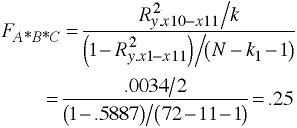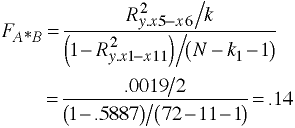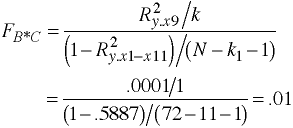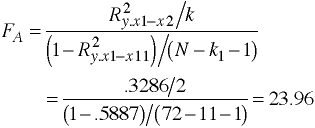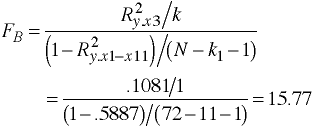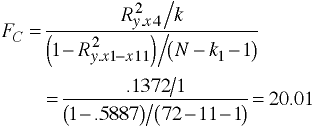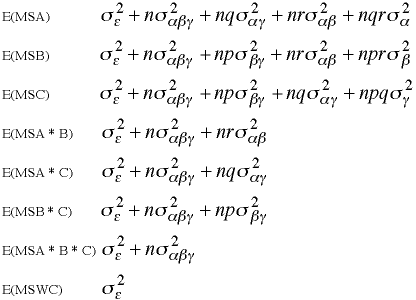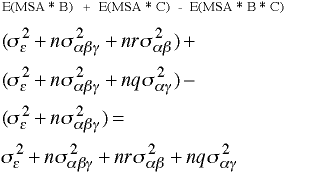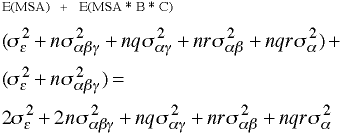A 3 Factor Completely Randomized Factorial Design
| A | |||||||
| a1 | a2 | a3 | |||||
| C | c1 | B | b1 | 27 22 45 28 76 33 | 31 37 52 45 86 66 | 55 62 76 85 104 126 | |
| b2 | 55 40 81 50 36 70 | 77 76 98 68 42 104 | 132 104 96 70 89 142 | ||||
| c2 | B | b1 | 61 39 76 60 46 59 | 61 71 82 92 103 105 | 140 122 99 92 68 101 | ||
| b2 | 88 92 95 103 51 73 | 100 120 120 131 89 76 | 142 150 96 105 80 125 | ||||
| A | |||||||
| a1 | a2 | a3 | |||||
| C | c1 | B | b1 | S1 n = 6 | S2 n = 6 | S3 n = 6 | |
| b2 | S4 n = 6 | S5 n = 6 | S6 n = 6 | ||||
| c2 | B | b1 | S7 n = 6 | S8 n = 6 | S9 n = 6 | ||
| b2 | S10 n = 6 | S11 n = 6 | S12 n = 6 | ||||
ANOVA Summary Table
| Source | SS | df | MS | F | |
| A Main effect | 23630 | 2 | 11815 | 24.64 | |
| B Main effect | 7667 | 1 | 7667 | 15.99 | |
| C Main effect | 9730 | 1 | 9730 | 20.29 | |
| A*B Interaction | 136 | 2 | 68 | .14 | |
| A*C Interaction | 752 | 2 | 376 | .78 | |
| B*C Interaction | 9 | 1 | 9 | .02 | |
| A*B*C Interaction | 224 | 2 | 112 | .23 | |
| Within Cells | 28769 | 60 | 479 | ||
| Total | 70917 | 71 |
Model for Orthogonal Coding
A B C A*B A*C B*C A*B*C
A B C X1 X2 X3 X4 X5 X6 X7 X8 X9 X10 X11
1 1 1 1 1 1 1 1 1 1 1 1 1 1
2 1 1 -1 1 1 1 -1 1 -1 1 1 -1 1
3 1 1 0 -2 1 1 0 -2 0 -2 1 0 -2
1 2 1 1 1 -1 1 -1 -1 1 1 -1 -1 -1
2 2 1 -1 1 -1 1 1 -1 -1 1 -1 1 -1
3 2 1 0 -2 -1 1 0 2 0 -2 -1 0 2
1 1 2 1 1 1 -1 1 1 -1 -1 -1 -1 -1
2 1 2 -1 1 1 -1 -1 1 1 -1 -1 1 -1
3 1 2 0 -2 1 -1 0 -2 0 2 -1 0 2
1 2 2 1 1 -1 -1 -1 -1 -1 -1 1 1 1
2 2 2 -1 1 -1 -1 1 -1 1 -1 1 -1 1
3 2 2 0 -2 -1 -1 0 2 0 2 1 0 -2
Stata Example
input y a b c x1 x2 x3 x4
27 1 1 1 1 1 1 1
22 1 1 1 1 1 1 1
45 1 1 1 1 1 1 1
18 1 1 1 1 1 1 1
76 1 1 1 1 1 1 1
33 1 1 1 1 1 1 1
31 2 1 1 -1 1 1 1
37 2 1 1 -1 1 1 1
52 2 1 1 -1 1 1 1
45 2 1 1 -1 1 1 1
86 2 1 1 -1 1 1 1
66 2 1 1 -1 1 1 1
55 3 1 1 0 -2 1 1
62 3 1 1 0 -2 1 1
76 3 1 1 0 -2 1 1
85 3 1 1 0 -2 1 1
104 3 1 1 0 -2 1 1
126 3 1 1 0 -2 1 1
55 1 2 1 1 1 -1 1
40 1 2 1 1 1 -1 1
81 1 2 1 1 1 -1 1
50 1 2 1 1 1 -1 1
36 1 2 1 1 1 -1 1
70 1 2 1 1 1 -1 1
77 2 2 1 -1 1 -1 1
76 2 2 1 -1 1 -1 1
98 2 2 1 -1 1 -1 1
68 2 2 1 -1 1 -1 1
42 2 2 1 -1 1 -1 1
104 2 2 1 -1 1 -1 1
132 3 2 1 0 -2 -1 1
104 3 2 1 0 -2 -1 1
96 3 2 1 0 -2 -1 1
70 3 2 1 0 -2 -1 1
89 3 2 1 0 -2 -1 1
142 3 2 1 0 -2 -1 1
61 1 1 2 1 1 1 -1
39 1 1 2 1 1 1 -1
76 1 1 2 1 1 1 -1
60 1 1 2 1 1 1 -1
46 1 1 2 1 1 1 -1
59 1 1 2 1 1 1 -1
61 2 1 2 -1 1 1 -1
71 2 1 2 -1 1 1 -1
82 2 1 2 -1 1 1 -1
92 2 1 2 -1 1 1 -1
103 2 1 2 -1 1 1 -1
105 2 1 2 -1 1 1 -1
140 3 1 2 0 -2 1 -1
122 3 1 2 0 -2 1 -1
99 3 1 2 0 -2 1 -1
92 3 1 2 0 -2 1 -1
68 3 1 2 0 -2 1 -1
101 3 1 2 0 -2 1 -1
88 1 2 2 1 1 -1 -1
92 1 2 2 1 1 -1 -1
95 1 2 2 1 1 -1 -1
103 1 2 2 1 1 -1 -1
51 1 2 2 1 1 -1 -1
73 1 2 2 1 1 -1 -1
100 2 2 2 -1 1 -1 -1
120 2 2 2 -1 1 -1 -1
120 2 2 2 -1 1 -1 -1
131 2 2 2 -1 1 -1 -1
89 2 2 2 -1 1 -1 -1
76 2 2 2 -1 1 -1 -1
142 3 2 2 0 -2 -1 -1
150 3 2 2 0 -2 -1 -1
96 3 2 2 0 -2 -1 -1
105 3 2 2 0 -2 -1 -1
80 3 2 2 0 -2 -1 -1
125 3 2 2 0 -2 -1 -1
end
generate x5=x1*x3
generate x6=x2*x3
generate x7=x1*x4
generate x8=x2*x4
generate x9=x3*x4
generate x10=x1*x3*x4
generate x11=x2*x3*x4
table a, cont(freq mean y sd y) by(b c)
----------+-----------------------------------
b, c and |
a | Freq. mean(y) sd(y)
----------+-----------------------------------
1 |
1 |
1 | 6 36.83333 21.38613
2 | 6 52.83333 20.31174
3 | 6 84.66666 26.65083
----------+-----------------------------------
1 |
2 |
1 | 6 56.83333 12.92156
2 | 6 85.66666 17.61439
3 | 6 103.6667 24.87301
----------+-----------------------------------
2 |
1 |
1 | 6 55.33333 17.38582
2 | 6 77.5 22.25084
3 | 6 105.5 27.05365
----------+-----------------------------------
2 |
2 |
1 | 6 83.66666 18.82197
2 | 6 106 21.17546
3 | 6 116.3333 27.31056
----------+-----------------------------------
histogram y, by(a b c) normal
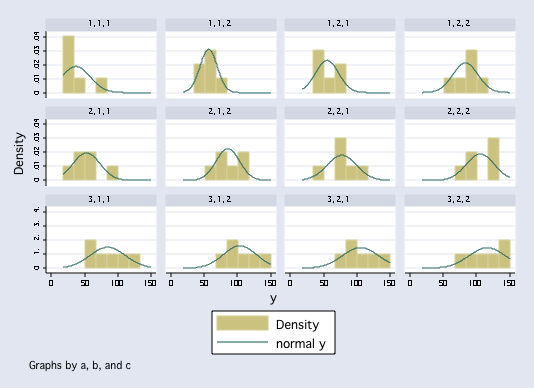 anova y a b c a#b a#c b#c a#b#c
Number of obs = 72 R-squared = 0.5943
Root MSE = 21.8973 Adj R-squared = 0.5199
Source | Partial SS df MS F Prob > F
-----------+----------------------------------------------------
Model | 42147.8194 11 3831.61995 7.99 0.0000
|
a | 23630.0278 2 11815.0139 24.64 0.0000
b | 7667.34722 1 7667.34722 15.99 0.0002
c | 9730.125 1 9730.125 20.29 0.0000
a#b | 136.194444 2 68.0972222 0.14 0.8679
a#c | 751.75 2 375.875 0.78 0.4612
b#c | 8.68055556 1 8.68055556 0.02 0.8934
a#b#c | 223.694444 2 111.847222 0.23 0.7927
|
Residual | 28769.5 60 479.491667
-----------+----------------------------------------------------
Total | 70917.3194 71 998.835485
regress y x1 x2 x3 x4 x5 x6 x7 x8 x9 x10 x11
Source | SS df MS Number of obs = 72
-------------+------------------------------ F( 11, 60) = 7.99
Model | 42147.8194 11 3831.61995 Prob > F = 0.0000
Residual | 28769.5 60 479.491667 R-squared = 0.5943
-------------+------------------------------ Adj R-squared = 0.5199
Total | 70917.3194 71 998.835485 Root MSE = 21.897
------------------------------------------------------------------------------
y | Coef. Std. Err. t P>|t| [95% Conf. Interval]
-------------+----------------------------------------------------------------
x1 | -11.16667 3.160603 -3.53 0.001 -17.48881 -4.84452
x2 | -11.06944 1.824775 -6.07 0.000 -14.71954 -7.419351
x3 | -10.31944 2.580621 -4.00 0.000 -15.48146 -5.157433
x4 | -11.625 2.580621 -4.50 0.000 -16.78701 -6.462989
x5 | -.0416667 3.160603 -0.01 0.990 -6.363813 6.28048
x6 | -.9722222 1.824775 -0.53 0.596 -4.622315 2.677871
x7 | 1.625 3.160603 0.51 0.609 -4.697147 7.947147
x8 | -2.083333 1.824775 -1.14 0.258 -5.733426 1.56676
x9 | -.3472222 2.580621 -0.13 0.893 -5.509233 4.814789
x10 | 1.583333 3.160603 0.50 0.618 -4.738813 7.90548
x11 | .8472222 1.824775 0.46 0.644 -2.802871 4.497315
_cons | 80.40278 2.580621 31.16 0.000 75.24077 85.56479
------------------------------------------------------------------------------
test x1 x2
( 1) x1 = 0.0
( 2) x2 = 0.0
F( 2, 60) = 24.64
Prob > F = 0.0000
test x3
( 1) x3 = 0.0
F( 1, 60) = 15.99
Prob > F = 0.0002
test x4
( 1) x4 = 0.0
F( 1, 60) = 20.29
Prob > F = 0.0000
test x5 x6
( 1) x5 = 0.0
( 2) x6 = 0.0
F( 2, 60) = 0.14
Prob > F = 0.8679
test x7 x8
( 1) x7 = 0.0
( 2) x8 = 0.0
F( 2, 60) = 0.78
Prob > F = 0.4612
test x9
( 1) x9 = 0.0
F( 1, 60) = 0.02
Prob > F = 0.893
test x10 x11
( 1) x10 = 0.0
( 2) x11 = 0.0
F( 2, 60) = 0.23
Prob > F = 0.792
anova y a b c a#b a#c b#c a#b#c
Number of obs = 72 R-squared = 0.5943
Root MSE = 21.8973 Adj R-squared = 0.5199
Source | Partial SS df MS F Prob > F
-----------+----------------------------------------------------
Model | 42147.8194 11 3831.61995 7.99 0.0000
|
a | 23630.0278 2 11815.0139 24.64 0.0000
b | 7667.34722 1 7667.34722 15.99 0.0002
c | 9730.125 1 9730.125 20.29 0.0000
a#b | 136.194444 2 68.0972222 0.14 0.8679
a#c | 751.75 2 375.875 0.78 0.4612
b#c | 8.68055556 1 8.68055556 0.02 0.8934
a#b#c | 223.694444 2 111.847222 0.23 0.7927
|
Residual | 28769.5 60 479.491667
-----------+----------------------------------------------------
Total | 70917.3194 71 998.835485
regress y x1 x2 x3 x4 x5 x6 x7 x8 x9 x10 x11
Source | SS df MS Number of obs = 72
-------------+------------------------------ F( 11, 60) = 7.99
Model | 42147.8194 11 3831.61995 Prob > F = 0.0000
Residual | 28769.5 60 479.491667 R-squared = 0.5943
-------------+------------------------------ Adj R-squared = 0.5199
Total | 70917.3194 71 998.835485 Root MSE = 21.897
------------------------------------------------------------------------------
y | Coef. Std. Err. t P>|t| [95% Conf. Interval]
-------------+----------------------------------------------------------------
x1 | -11.16667 3.160603 -3.53 0.001 -17.48881 -4.84452
x2 | -11.06944 1.824775 -6.07 0.000 -14.71954 -7.419351
x3 | -10.31944 2.580621 -4.00 0.000 -15.48146 -5.157433
x4 | -11.625 2.580621 -4.50 0.000 -16.78701 -6.462989
x5 | -.0416667 3.160603 -0.01 0.990 -6.363813 6.28048
x6 | -.9722222 1.824775 -0.53 0.596 -4.622315 2.677871
x7 | 1.625 3.160603 0.51 0.609 -4.697147 7.947147
x8 | -2.083333 1.824775 -1.14 0.258 -5.733426 1.56676
x9 | -.3472222 2.580621 -0.13 0.893 -5.509233 4.814789
x10 | 1.583333 3.160603 0.50 0.618 -4.738813 7.90548
x11 | .8472222 1.824775 0.46 0.644 -2.802871 4.497315
_cons | 80.40278 2.580621 31.16 0.000 75.24077 85.56479
------------------------------------------------------------------------------
test x1 x2
( 1) x1 = 0.0
( 2) x2 = 0.0
F( 2, 60) = 24.64
Prob > F = 0.0000
test x3
( 1) x3 = 0.0
F( 1, 60) = 15.99
Prob > F = 0.0002
test x4
( 1) x4 = 0.0
F( 1, 60) = 20.29
Prob > F = 0.0000
test x5 x6
( 1) x5 = 0.0
( 2) x6 = 0.0
F( 2, 60) = 0.14
Prob > F = 0.8679
test x7 x8
( 1) x7 = 0.0
( 2) x8 = 0.0
F( 2, 60) = 0.78
Prob > F = 0.4612
test x9
( 1) x9 = 0.0
F( 1, 60) = 0.02
Prob > F = 0.893
test x10 x11
( 1) x10 = 0.0
( 2) x11 = 0.0
F( 2, 60) = 0.23
Prob > F = 0.792From Computer Example
regress y x1 x2 x3 x4 x5 x6 x7 x8 x9 x10 x11 /* m0 */ regress y x1 x2 /* m1 */ regress y x3 /* m2 */ regress y x4 /* m3 */ regress y x5 x6 /* m4 */ regress y x7 x8 /* m5 */ regress y x9 /* m6 */ regress y x10 x11 /* m7 */
Regression Results Summarized
Model: m0 R-squared 0.5943 Model: m1 R-squared 0.3332 Model: m2 R-squared 0.1081 Model: m3 R-squared 0.1372 Model: m4 R-squared 0.0019 Model: m5 R-squared 0.0106 Model: m6 R-squared 0.0001 Model: m7 R-squared 0.0032F-ratios Using Regression
